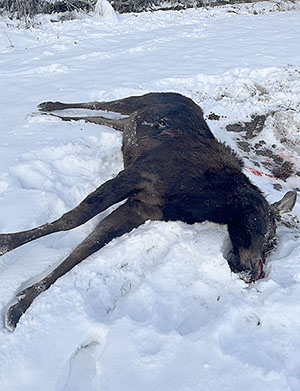Poachers shot a cow moose in a field near the town of Ontario on Jan. 16, and the Oregon Hunters Association is offering a reward of $2,000 for information that leads to an arrest or citation in this case.
Reporting parties may remain anonymous and can opt for five hunter preference points in lieu of the cash.

Oregon State Police Fish & Wildlife troopers received a call from the public reporting a cow moose that had been shot and left to waste in an agricultural field located off East Island Road in the Beulah Wildlife Management Unit. The location is about one mile east of the city or Ontario, near the Idaho border.
The moose may have crossed into Oregon from Idaho, where they are well established, however there is a small local population, according to Tucker Freeman, district wildlife biologist based in Ontario.
“We have historically held a very small Shiras moose population in Malheur County on the order of maybe a few verified sightings per year,” Freeman said, “The majority of these sightings occur in the Snake River drainage and most everyone we speak with is very pleased with the opportunity to have seen a moose in the area.”
Moose historically are not native to the state and there is no legal hunting season for the largest of the Cervidae family, which includes elk, deer and pronghorn. Moose migrated to Oregon from Washington or Idaho and in 1960, biologists received the first confirmed sightings of moose in northeast Oregon. From 2001-2006 the number of sightings increased substantially in the Blue Mountains, including the first documented calf in 2005.
Today there are an estimated 50 adults and calves in the area. The Oregon Department of Fish & Wildlife began monitoring moose in 2006 and placed radio collars on six moose in 2008 to obtain baseline information on reproduction, habitat use, and seasonal movements. The captured moose appeared healthy.
The recent poaching case has ODFW biologists disappointed, according to Freeman.
“We are committed to supporting the Oregon State Police in seeking justice to the case and would like to emphasize the preference points and cash rewards available for tips leading to an arrest or citation,” he said.
Moose have a dark brown coat that blends to light brown or grey on their legs. Their muzzle is broad and overhanging, and the palmate antlers of adult males are massive. Moose have a “bell” (waddle like flap of skin) on the throat.
Anyone with information regarding this investigation is urged to contact Sr. Trooper Casey Hunter through the Turn in Poachers (TIP) hotline at 1-800-452-7888 or dial *OSP (mobile) and reference case number SP24017131. Callers may remain anonymous.









